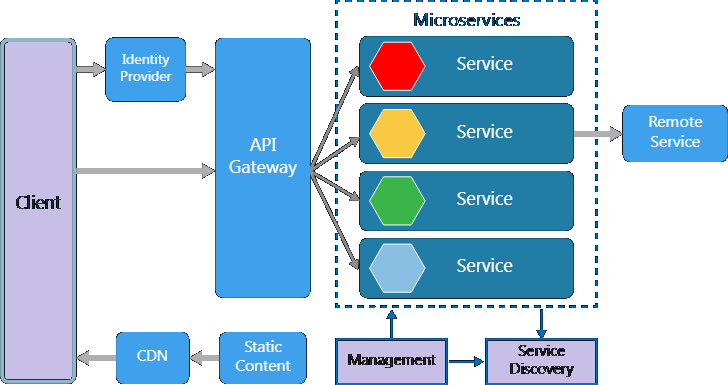Microservices is an architectural style that structures applications as small autonomous services. It provides for rapid and reliable delivery of complex applications. It’s distributed and loosely coupled, so changes in one team won’t break the entire application.
However, it requires heavy investment and teams must be able to synchronize well to ensure smooth collaboration. Additionally, end-to-end testing is challenging.
What is Microservices?
Microservices is a software development model in which an application is broken down into smaller parts, each independently deployable and scalable. These services communicate with each other via APIs. This approach allows for faster development, continuous integration and deployment, and better scalability than traditional monolithic applications. It is also easier to test and monitor the entire system because each component is a distinct service.
A microservice architecture can be deployed in a variety of environments, and developers can scale each service individually. Its flexibility makes it a good complement and enabler of DevOps, CI/CD, and automation. It can also help shorten QA and release cycles, and it provides more control over the stability of an application.
One of the key benefits of microservices is that they can be developed by teams working on different parts of an application at the same time. This is similar to LEGO builders building their specific sections of the castle at the same time, and it helps build more flexible and adaptable systems.
Another benefit is that microservices can be deployed independently of each other, which allows for more agile processes and faster iteration. This means that the code can be changed and deployed to production quickly, which is important for businesses looking to be competitive in their markets. Microservices can be used with different technologies, but some of the most popular are Docker, Spring Boot, and Apache Maven.
What is Spring Boot?
Spring Boot is an open-source framework that simplifies development of Java web applications and microservices. It is based on the Spring framework and embedded servers, and it uses convention over configuration software design to autoconfigure application components. It reduces developer time and increases productivity.
It offers an API for building RESTful services, which helps in writing complex microservices. It supports Java, Kotlin, and other languages, and it also provides containers and unparalleled scalability. It is also easy to deploy and manage in the cloud, making it a great choice for developers looking to modernize their applications.
In addition, it allows for quicker unit and integration testing, and it can be used to create a microservice-based architecture. It has a large user community and free learning materials.
The Spring framework is a powerful Java programming language that can be used to build enterprise-grade projects. It supports a wide variety of features, including dependency injection and aspect-oriented programming. It also has a huge library of plugins that can simplify tasks and improve productivity. However, the Spring framework requires a lot of code and has many dependencies, which can slow down development. Spring Boot is a lightweight version of the Spring framework that eliminates the need for XML configuration and reduces boilerplate code. It also includes support for in-memory databases, which can speed up development time.
What is Spring Cloud?
Spring Cloud is a set of tools and extensions to the Spring framework. It provides solutions to common problems observed in distributed environments like load balancing, circuit breaking, and service discovery. It also helps developers focus on building applications by simplifying development and deployment.
Its features include a gateway to manage and route API calls (zuul and ribbon) for performance and security, and an event bus to propagate configuration changes in microservice instances. It also enables you to connect and scale microservices with shared messaging systems through a declarative message integration layer with Kafka, RabbitMQ, and Redis. It also provides tracing capabilities through distributed tracing (e.g., Zipkin and HTrace) and log-based tracing through Hashicorp Consul or Amazon ELK.
Many of the Spring Cloud components are taken from OSS components developed by Netflix to manage their massive-scale microservices. These homegrown components are fundamentally crafted to fill the gaps in existing software platforms that they found when managing their services. They are battle-tested in production systems and widely adopted in the industry.
As more and more enterprises adopt the microservices architecture, the need for these tools becomes even more obvious. This is because they help simplify development, deployment, and maintenance while providing better fault tolerance and scalability. However, there are some challenges that come along with this approach, especially when implementing complex applications in production.
What is Docker?
Docker is an open source containerization platform. It allows developers to package software applications and all the dependencies that support them into a single unit. The application can then be run on any Linux server that supports the Docker engine. Docker is used to develop, test and deploy Microservices applications.
Microservices is an architectural approach to building software where large applications are broken down into small independent services that communicate with each other, enabling flexibility and scalability. This development style is often compared to building a Lego castle, where each team takes responsibility for one block of the castle, rather than trying to build the whole thing at once (the monolithic approach).
A Microservices architecture has several benefits, including faster application delivery, more reliable deployment and a more flexible, modular design. It also allows teams to work together, which can lead to a faster release cycle and higher code quality.
There are several challenges when working with Microservices, such as code testing and scalability. Because the microservices may use different programming languages, have different data sources and operate on different operating systems, it is challenging to test them as a whole. To help overcome this challenge, many organizations use a model called the Test Pyramid. This model recommends that the number of tests should increase from unit tests to service tests and then end-to-end tests.

